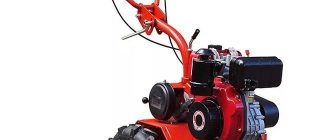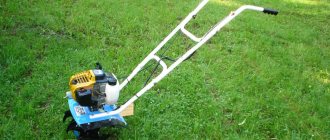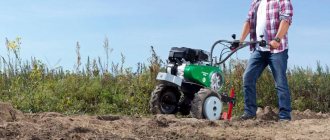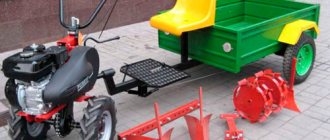Walk-behind tractors and walk-behind cultivators: what's the difference?
Working on the ground requires considerable effort. Modern technology can significantly simplify this difficult work. For example, walk-behind tractors and walk-behind cultivators will make plowing, weeding, hilling and some other operations easier. The main difference between a motor cultivator and a walk-behind tractor is the power and the number of operations they can perform.
They are similar in purpose, but differ in power, number of operations performed, and depth of tillage.
Motor cultivators are small, lightweight devices with a capacity of 3-6 horsepower. The main purpose is to loosen the soil using a milling cutter. Other operations and work with other implements are possible, but not on all models and not with all soils.
Walk-behind tractors are more powerful devices - from 7 hp. - with a wide range of functions. They can cope with plowing (working with a plow), loosening (milling cutter), hilling, mowing grass, etc. As an additional function - the ability to transport goods or move a small trailer.
Technical indicators
The main elements of the walk-behind tractor
- The engine
is the main part of the unit, which is responsible for the operation of the entire mechanism. The quality of the engine guarantees the long service life of the walk-behind tractor itself. Engines come in gasoline and diesel types depending on the type of fuel. Gasoline units are divided according to the number of cycles of operation into two-stroke and four-stroke, and the latter are considered more economical and more productive. The engine starts in different ways: either with the help of a crank handle or with the help of an electric starter. It all depends on the chosen model. - The clutch
has the same function as in any passenger car. The main goal is to transfer motion from the engine through the transmission to the wheels. In the absence of a clutch, the unit immediately begins to move when starting, and to change the speed it would have to be disengaged. The clutch includes a belt drive using one or two scroll discs. A double-disc clutch is designed for heavy types of equipment. - A gearbox
is a device for trouble-free operation of a walk-behind tractor that regulates its power. There are gear (gear-chain) and worm gearboxes. - The transmission
is another element that transfers rotational energy from the engine to the wheels. There are gear, gear-worm and gear-worm-belt transmissions. When buying a walk-behind tractor, the type of transmission does not play a primary role. - The handles
are the metal part of the walk-behind tractor with rubber bracelets at the ends. The handles play the function of a steering wheel during operation, and also carry control and adjustment buttons; - Wheels.
Standard wheels have a large diameter and are pneumatic, i.e. filled with air. The main function is to move the unit. Separately, lugs are distinguished as a type of wheels for a walk-behind tractor. This option is used for direct work on the ground: hilling, digging up potatoes, etc.
We advise you to study - What is cheaper: metal tiles or soft roofing
Attachments and trailed equipment
The functions of the walk-behind tractor directly depend on the additional “attachments” that are attached to the body of the device. Attachments are associated with the operation of the shaft, i.e. becomes part of the propulsion mechanism, the trailed equipment is attached to the unit without direct dependence on the engine.
When purchasing a walk-behind tractor, several of the most commonly used types of equipment are included. Additionally, you can purchase equipment in the store.
What to choose
How to choose what to buy? What is better, walk-behind tractors and walk-behind cultivators? Depends on the size of the area that you plan to cultivate, the list of works that you want to automate, and the soils on the site.
What to choose? Walk-behind tractor or cultivator
Where and for what is it better to use motor cultivators
For a dacha, garden, or vegetable garden with an area of up to 10-15 acres, a motorized cultivator is quite sufficient. Especially if the soils are light. This device does a good job of loosening the soil and cultivating row spacing, but it usually works at one speed. Only some, more expensive models can have two speeds; even less common is the ability to change the direction of movement (reverse).
The main equipment is cutters. They come in different sizes for different row spacings. Replacing a cutter takes little time, which is convenient. Only the heaviest and most powerful (read: expensive) models can cope with plowing, and even then, on light and medium soils. Moreover, we are not talking about deep processing.
Small motor cultivators are the best choice for processing small areas
Some owners adapt hillers to more powerful models. The quality of processing is not always high. It is normal only on light soils. Even with preliminary loosening, the row spacing has to be adjusted manually. Although the work is certainly much easier.
The wheel, most often, is one - central, solid. That is, during operation, some effort will be required to keep the tool in a stable position. In general, for a standard summer cottage, a motor cultivator is an excellent choice. Larger areas require more powerful equipment.
Scope of application of walk-behind tractors
If the area of the cultivated area exceeds 20 acres, it makes sense to buy a walk-behind tractor. Unlike motorized cultivators, they have several transmission speeds and the ability to reverse. There are usually few speeds, 2-3 when moving forward and 1-2 when moving backward.
Walk-behind tractors are needed for large areas
The number of attachments for walk-behind tractors is greater: in addition to cutters, you can install a plow, mower, and hiller. Due to the greater power, soil cultivation proceeds faster and greater depth is possible. The depth changes due to the installation of weights that lower the cutter or plow lower.
Walk-behind tractors have two pneumatic wheels, making them more stable. The effort required when working is minimal; you just have to control the direction.
Which is better, a walk-behind tractor or a cultivator?
What to choose: walk-behind tractor or cultivator?
Having trouble choosing? Let's turn to the main characteristics and principles of operation of these technical means. Both types of equipment are designed to perform the same tasks, such as: cultivation, plowing, creating furrows and cutting ridges, hilling, weed control, planting potatoes, preserving moisture, clearing snow, etc. However, with the same tasks, the conditions are different, and they are characterized by the following factors:
- soil density: sandy, loamy, peat, virgin soil
- area of cultivated area: 5 acres or 5 hectares.
- purpose of the cultivated area: large personal plot, field, vegetable garden, greenhouse, garden, flower bed
- the presence of bushes and trees between the ridges
When choosing a technical tool, you should also be aware of such points as:
- in order to extend the service life of the unit, it makes sense to buy a technical device with some power reserve
- the quality of cultivation depends on the depth of processing
- The speed and complexity of cultivation depend on engine power and processing width.
- if the soil is dense or heavy, it is more convenient to process with removable or collapsible cutters
- factor of the possibility of adjusting the width of the treated surface, because in small areas or in greenhouses, the larger width of the processed part also requires a larger turning radius, which is not always convenient and can reduce the maneuverability of the equipment
- transmission: gear is designed for significant loads and is used in semi- and professional equipment, and transmission of rotation from the engine to the gearbox via a belt or chain is used in lighter models designed for small processing areas
- wheels: as a rule, in motor cultivators, wheels replace movable equipment, which is transported to the front axle
- power take-off shaft: designed for the use of additional attachments, as well as attachments with moving elements (mower, snow blower). If there is no power take-off, then the technical device can only be used as a draft mechanism.
We advise you to study - How to choose a fan heater: an overview of models and their characteristics
It is better to choose a motor cultivator:
- treatment of the upper layers of the soil is required: hilling, loosening, moisture conservation, weeding
- if the processing area is no more than 10 acres
- there is a need to work in confined spaces (greenhouse, greenhouse, flower bed)
- the cultivated soil is not particularly dense (however, if the cultivator has enough power and special cutters are used, the unit is capable of cultivating even virgin soil)
- As a rule, motor cultivators are more compact, maneuverable and lightweight, so people of different age categories and physical characteristics can work with them.
It is better to choose a walk-behind tractor:
- if the processing area is more than 10 acres
- there is no need to work in confined spaces (greenhouse, greenhouse, flower bed) up to 20 acres: recommended power 3-6 hp, processing width - up to 70 cm. over 20 acres: power - 8-13 hp, processing width from 80 cm to 110 cm, depth up to 30 cm.
- The weight of a walk-behind tractor ranges from 70 to 120 kg, so a specialist working with fairly heavy equipment needs to have strong physical training.
- The walk-behind tractor, when using attachments, can be used as a traction device and used as a cargo vehicle.
Qualified employees will approach any order in a friendly and attentive manner, competently advise on the technical features of the chosen model and help, if necessary, make the best purchase choice, taking into account your economic needs and financial capabilities.
Also a nice bonus is that all purchased equipment, at the buyer’s request, is delivered assembled, filled with oil and gasoline.
F-Park team
In accordance with the Copyright Law, this material is permitted for copying and posting on other resources and media only with a link to the source https://f-park.by/
Division into classes
Walk-behind tractors and walk-behind cultivators are divided into three classes. The choice of class depends on the type of soil being cultivated and the area of the site. There are light, medium and heavy cultivators and walk-behind tractors.
- Lungs. Suitable for cultivating light, previously treated soils. They are characterized by low power and weight, as a rule, they have a small processing area in one pass. These are cultivators for a summer house, small garden and vegetable garden with annual tillage. They are characterized by high maneuverability. But, due to their low weight, significant efforts have to be made to stabilize their position. This especially affects working with light motor cultivators - you have to apply good pressure so that the cutter remains at the desired depth. Mastering new areas with equipment of this class is very problematic and can lead to rapid wear. Motor cultivators of different classes
- Average. Suitable for working on medium-density soils. Thanks to its more substantial weight, processing is possible to a greater depth. It can also be used in dachas, but it also works well on medium-heavy loams and fertile soils. Due to the greater weight, the equipment is more stable and does not jump out of the ground during operation. Maneuverability is still high. Medium-class walk-behind tractors are suitable for cultivating plots of up to half a hectare; with motor-cultivators of this type, work goes faster, although they are not designed for cultivating large areas.
Walk-behind tractors - light, medium, heavy - for areas of different sizes
- Heavy. Universal units for cultivating any type of soil, including virgin soil cultivation. Suitable for transporting crops and for working with other mounted implements (mower). It is advisable to buy if you are cultivating more than a hectare of heavy soil or two or more hectares of light soil. Due to the greater weight and dimensions, maneuverability is less, but the processing width and possible depth are greater.
In general, it is not difficult to choose walk-behind tractors and walk-behind cultivators by class. Light and medium-sized models of motorized cultivators are suitable for dachas; walk-behind tractors are more suitable for farms. The class will have to be determined by the soil and size of the cultivated area.
Engine type and its parameters
Walk-behind tractors and motor-cultivators are equipped with an engine. The speed and depth of processing, the ability to work with different types of soil, and the size of the tools used depend on its type and power. In general, choosing an engine is an important task.
You need to choose a walk-behind tractor and a walk-behind cultivator by engine type
engine's type
Walk-behind tractors and walk-behind cultivators are produced with three types of engines:
- Electrical engine. Small models are equipped with an electric motor for processing plots of 5-6 acres. These devices are ideal for working in greenhouses, where the use of internal combustion engines is impossible due to the enclosed space. It is also the most inexpensive cultivator for the garden. Price range: from $100 to $600. There are very small units with a power consumption of 0.75 kW (-3 horsepower), and there are more substantial units with an engine power of up to 2.2 kW (up to 7 horses). Among the features of the choice is to pay attention to the phase pattern of the network (380 V or 220 V), the length of the cord and the type of its fastening. Only light motor cultivators have an electric motor.
- Gas engine. Motor-cultivators and walk-behind tractors of the light and medium class are equipped with 2-stroke gasoline engines, heavy and some larger medium-sized ones are equipped with 4-stroke engines. When choosing, you need to pay attention to the engine size and its power. The larger these parameters are, the greater the “draft” force the unit has. Prices range from $120 to $500 (there are also more expensive models, mostly made in Europe).
- Diesel engine. Models of the middle and heavy class are equipped with diesel engines, and they are installed almost exclusively on walk-behind tractors, and only some heavy-class cultivators can have such an engine. The engines are predominantly 4-stroke, single-cylinder. When choosing, you should also look at the engine size and its power. Prices from 500 to 2000 $.
The most common choice is a gasoline engine. Diesel engines, of course, are more economical during operation, but the price of models with similar characteristics is very different. So most often they choose walk-behind tractors and walk-behind cultivators with gasoline engines.
Gearbox type
A gearbox is a unit that transmits torque in a gearbox. The type of gearbox affects the durability of the unit, the noise level during operation, and the smoothness of speed changes. In general, this is an important node.
Gearboxes on walk-behind tractors and walk-behind cultivators are:
- Worm gear. Commonly used on single-speed gearboxes equipped with light cultivators. The worm gear is low noise, features smooth operation, low noise level, and high efficiency. Disadvantage: fragility.
- Chain reducer. Suitable for light and medium walk-behind tractors and medium/heavy cultivators. There is a driving sprocket on the engine axis, and a driven sprocket on the working shaft. They are connected by a chain. By changing the gear ratio, the force on the working equipment is changed, so you can select the force required for each job. The chain reducer can be dismountable or non-dismountable. In a collapsible version, worn parts (sprockets) can be replaced. The non-separable one is replaced entirely. The disadvantage of a chain gearbox is its high noise level. Chain gear is noisy, but easy to repair
- Gear reducer. Consists of a set of combinable gears. Such gearboxes are found on medium and heavy walk-behind tractors; they cannot be found on cultivators. The most reliable gearbox, designed for heavy loads, but also the most expensive. You won't find it in budget models. The disadvantage is expensive maintenance.
Gear reducer is the most reliable
Actually, the choice is actually small. Cultivators are mainly equipped with worm gearboxes. Only some, more expensive heavy ones have chain ones. Light and medium-sized walk-behind tractors (even budget heavy ones) are equipped with chain gearboxes and only expensive heavy ones have gear drives.
Number of speeds
Inexpensive light and medium cultivators do not have a gearbox and they always work with the same force. For simple, same-type work - loosening - this is normal. More powerful equipment - heavy cultivators and all walk-behind tractors - have a box. The number of speeds is from 2 to 8. The more speeds, the more accurately you can select the force for a specific job. This ultimately saves fuel.
The number of speeds is important for ease of use
Even more “advanced” modifications have the ability to change the direction of movement - they can move backwards. This is convenient in limited space, but the gearbox is more complex and costs more. The number of speeds during reverse movement is smaller - from one to three.
Transmissions with reverse can be mechanical or automatic. Automatic ones change direction while driving; with mechanical ones, to reverse, you must first stop and then change gear. It is clear that automatic ones are more complex and cost more (and also in maintenance).
What engines and fuel are used in cultivators
Unlike walk-behind tractors, cultivators can be powered by electricity. This is convenient if you have an oversized area near your house with electricity. But large areas will require the use of powerful and heavy gasoline cultivators.
Petrol engines of cultivators are small and operate at high speeds. As with walk-behind tractors, the engine can be two-stroke or four-stroke. The latter option is preferable: it makes less noise and consumes less fuel.
instrumenti.by
RUB 930.15
All stores (10)
Petrol cultivator Champion BC5712
from 818.03 to 1,136.00 rub.
Petrol; power: 6.5 hp; engine capacity: 196 cm3; fuel tank volume: 3.6 l; cultivation width: 850 mm; cultivation depth: 330 mm; weight 52 kg.
Description Where to buy (10)
There are also diesel models: you can work for a long time at low speeds.
Motor cultivators: selection options, which one is better, prices, reviews
Let's start with how to choose a motor cultivator and what parameters to choose from. Then we will consider the most popular models, their advantages and disadvantages, and prices.
Motor cultivators - difficult to choose the best
Criterias of choice
The general parameters have already been described above: these are class, power, type of engine, gearbox and number of speeds. Here we briefly list the main selection criteria and the possible range of parameters. Here's what we pay attention to when choosing a motorized cultivator:
- The direction of rotation of the cutters. There is direct and
- Rotation speed of cutters (for models that operate at the same speed).
- Number of cutters included and their sizes.
- Processing width. From 15 cm to 110 cm.
- Processing depth. From 15 cm to 25 cm
- Wheel type. A good option is made of cast rubber, but the best is hydraulic (installed on some heavy models).
Walk-behind tractors work well
Also in each class, pay attention to the mass. It varies over a fairly wide range:
- light motor cultivators - from 9 kg to 40 kg (the lightest - with an electric motor);
- medium - from 40 kg to 80 kg;
- heavy - from 80 kg to 140 kg.
The choice by weight is also not entirely clear-cut. On the one hand, the smaller the mass, the better the maneuverability. On the other hand, the heavier the equipment, the greater the processing depth (although the relationship is not direct, much depends on the design). The advantage of greater mass is that heavier units can be loaded with homemade devices and used for uncharacteristic work.
Popular models, reviews, prices
Neva - popular domestically produced motor cultivators (Petersburg). They are designed to take into account the difficult soils that are typical for Russia, so middle-class cultivators have a gear drive. Additional advantages include a stable design and vibration damping. So it’s a pleasure to work with, reviews are 4 or 5 on a five-point scale. The characteristics of some models of Neva motor cultivators are collected in the table.
There are also Russian motorized cultivators from the SoyuzMash plant (Vyatka brand). They are less known and not available in every store. According to users, the quality is somewhere around 4.
Motoblocks: which is better, prices, reviews
As already mentioned, walk-behind tractors are designed for cultivating large areas and cope with the development of virgin soil. The main parameters are the same: engine type (gasoline or diesel), transmission type, power, number of speeds. There are also specific ones that are specific to this equipment.
When working with walk-behind tractors, physical effort is required to hold it in the required position.
Criterias of choice
Need to track:
- Class,
- soil tillage parameters (width and depth);
- fuel tank volume;
- type of gearbox (manual or automatic).
Can be used with a variety of attachments
What else is worth paying attention to is the number of attachments that can be used with this unit. But this needs to be clarified with the sellers, since such “little things” are not written in the technical specifications.
Best models according to reviews
The list is compiled based on reviews from owners. The rating includes walk-behind tractors of different classes, but their rating is not lower than “4” points out of five.
- CAIMAN VARIO 70S TWK+. A lightweight walk-behind tractor, equipped with a Subaru-Robin gasoline engine with 7 horsepower. The processing depth is up to 32 cm. The reliability and stability of the unit is noted, the possibility of use for plowing virgin soil and transporting goods. The assembly is French, the price is about $1000.
- KaDvi Oka MB-1D1M10. Medium walk-behind tractor with a Lifan 168F-2A engine with 6 horsepower. Manual transmission, 2 speeds forward, 2 reverse. Chain gearbox with belt drive. Good performance on virgin soil is noted, but gear shifting is a little difficult, and oil leakage is noted. According to reviews - 4. Price - $470. Motoblock KaDvi Oka MB-1D1M10 has good reviews
- Neva MB-23B-8.0. Middle class walk-behind tractor. Briggs and Stratton 8 horsepower petrol engine. Manual transmission, 4 speeds forward, 2 reverse, gear reducer. The disadvantages include difficult gear shifting and the lack of an electric starter. Otherwise the work is normal. Price: $880.
- Salute 100-6.5. Light class, Lifan 168F-2B engine with 6.53 horsepower. Manual transmission with two forward and one reverse speeds. Reviews note good torque, easy start, and confident maneuverability. Price 500$.
These are not all walk-behind tractors and cultivators. Only those that caught my eye and had good reviews.




